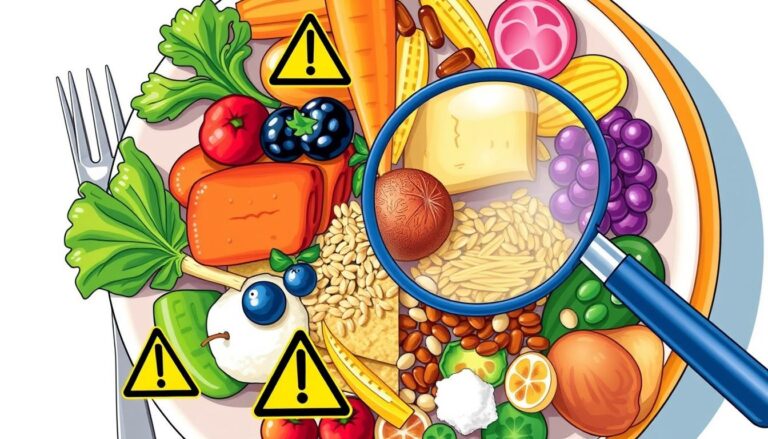Weight reduction might seem like a never-ending struggle for a lot of people. Fad diets, contradictory data, and unreasonable expectations are all around us.
Underneath all the commotion, however, is a simple fact:
knowing your caloric intake and energy balance is the key to successful weight control. To help you make better decisions for your health, this article will walk you through this important idea. Understanding the basics of calories in versus calories out can make a significant difference in achieving your weight loss goals.

By tracking your food intake and physical activity, you can gain a better understanding of how your body responds to different inputs. With this knowledge, you can make informed decisions about what to eat and how to exercise in order to maintain a healthy weight.
By focusing on the fundamentals of energy balance, you can cut through the noise of trendy diets and misinformation to create a sustainable and effective weight management plan.
Total Energy vs Expenditure The Calorie Formula
Think of your physical being as an advanced machine. Every aspect of its everyday life, from breathing and digesting to thinking and moving, is powered by fuel, which is the energy it derives from food. When the quantity of energy ingested calories in matches the energy burned calories out, weight stays steady.
Weight gain occurs when caloric intake exceeds caloric expenditure, and weight reduction occurs when caloric expenditure is less than caloric excess.
Maintaining a balance between intake and expenditure is crucial for overall health and well-being. It is important to be mindful of the types of foods consumed, as well as the amount, to ensure that the body is receiving the necessary nutrients and energy.
Regular physical activity is also essential in helping to regulate weight and promote a healthy metabolism. By being conscious of both food intake and physical activity individuals can work towards achieving and maintaining a healthy weight.
Here’s a breakdown of the calories out side of the equation:
The very minimum number of calories your body requires to maintain normal function at rest, even while you’re asleep, is known as your basal metabolic rate BMR. It accounts for around 60–70% of your daily calorie expenditure.
Thermic Effect of Meals TEF:
The energy your body requires to digest and absorb meals. It normally equals 10% of the daily calorie burn. TEF is often higher for protein-rich foods, as the body expends more energy to break down and process protein compared to carbohydrates and fats.
Eating smaller, more frequent meals throughout the day can also help increase TEF, as the body has to work more frequently to digest food. Overall, being mindful of your TEF can help boost your metabolism and aid in weight management.

Physical Activity Energy Expenditure PAEE :
This involves all your motions, from fidgeting to exercising. It might vary greatly based on your exercise level and intensity. The more vigorous and intense your physical activity, the higher your PAEE will be.
For example someone who runs for an hour will have a much higher PAEE than someone who takes a leisurely walk for the same amount of time. Monitoring your PAEE can help you track your overall energy expenditure and make adjustments to your exercise routine as needed.
Demystifying Calorie Needs It’s Not a One Size Fits-All
Several things determine your unique calorie needs:
Age: BMR normally lowers with age as muscle mass diminishes.
Sex: Men often have a higher BMR owing to their larger muscular mass.
Body Size: Larger bodies need more calories to sustain fundamental functions.
Activity Level: The more active you are, the more calories you burn.
Genetics: Genes have a role in metabolism and how effectively your body utilizes energy.
Calculating Your Calorie Needs:
Numerous online calculators and applications estimate your daily calorie requirements depending on your BMR, exercise level, and objectives. However, they are beginning points. It’s advisable to measure your calorie consumption and weight for a few weeks to determine how these estimations fit with your reality.
Fine tune your calorie intake depending on your weight reduction progress. This can help you understand how your body responds to different calorie levels and make necessary adjustments to meet your weight loss goals.
Keep in mind that everyone’s body is different, so what works for one person may not work for another. By monitoring your progress and making adjustments as needed, you can create a personalized plan that will help you achieve your desired results.
Remember to consult with a healthcare professional before making any significant changes to your diet or exercise routine.
Beyond the Numbers Making Informed Food Choices
While calorie tracking is a vital tool, it shouldn’t overwhelm the quality of your food. Here’s how to make wise decisions within your calorie budget:

Focus on Whole Foods:
Prioritize fruits, vegetables, whole grains, lean meats, and healthy fats. These meals are nutrient-dense keeping you satisfied for longer and supplying critical vitamins and minerals for optimum health. By prioritizing whole foods, you are also reducing your intake of processed foods that are often high in unhealthy fats, sugars, and preservatives.
This can lead to better weight management, improved energy levels, and a lower risk of chronic diseases such as diabetes and heart disease. Making whole foods the foundation of your diet can have a positive impact on both your physical and mental well-being.
Limit processed foods.
These are frequently heavy in calories, bad fats, added sugars, and salt, having limited nutritional value.Portion Control: Even nutritious meals might lead to weight gain if taken in excess.
Use measuring glasses, measure your intake using apps, or practice mindful eating to minimize overconsumption.
Portion control is crucial to maintaining a healthy weight and preventing overeating. By being mindful of how much you are eating, you can better manage your caloric intake and ensure you are not consuming more than your body needs.
This can also help you feel more satisfied with smaller portions and prevent the temptation to overindulge. Remember, moderation is key when it comes to maintaining a balanced diet and a healthy lifestyle.
Read food labels.
Pay attention to serving sizes and calorie counts. Be careful of hidden sugars and seek lower-calorie options wherever feasible.
Additionally look for products with fewer saturated fats and sodium. Choose whole foods like fruits, vegetables, and lean proteins over processed snacks.
Making small changes in your diet can lead to better overall health and weight management. Remember to stay hydrated and listen to your body’s hunger and fullness cues.
The Power of Movement Exercise for Sustainable Weight Loss
Exercise is an essential companion to weight control. Here’s why:
Boosts Metabolism:
Physical activity boosts your calorie expenditure, both during and after your exercise. Builds Muscle Mass: Muscle burns more calories at rest than fat, further increasing your metabolism.
Strength training exercises, such as weightlifting or bodyweight exercises, are particularly effective at building muscle mass. By incorporating these types of exercises into your workout routine, you can increase your muscle mass and, in turn, boost your metabolism even more.
This can lead to more efficient calorie burning throughout the day, even when you’re not actively exercising.
In addition to helping with weight management, building muscle mass can also improve your overall strength and endurance.
Improves Insulin Sensitivity:

Exercise helps your body use insulin efficiently, controlling blood sugar levels and reducing weight gain. Regular physical activity can also help prevent or manage type 2 diabetes by increasing insulin sensitivity. By incorporating exercise into your routine, you can decrease the risk of developing complications related to insulin resistance and maintain a healthier body weight.
Additionally, staying active can improve overall cardiovascular health and reduce the likelihood of developing chronic diseases associated with obesity and insulin resistance.
Benefits of Mental Wellbeing:
Exercise may reduce stress, enhance mood, and raise motivation, all of which contribute to effective weight control. Additionally, maintaining good mental wellbeing can also improve sleep quality and increase energy levels.
When our minds are in a positive state, we are more likely to make healthier choices when it comes to our diet and lifestyle. Overall, prioritizing mental wellbeing can lead to a happier and more balanced life.
Aim for a mix of:
Cardio: Activities like brisk walking, jogging, swimming, or cycling boost your heart rate and burn calories effectively.
Strength Training: Building muscular mass not only enhances your body but also boosts your BMR for long-term calorie burning.
Start with things you love and gradually increase intensity and time to keep your exercises interesting and effective.
Debunking Diet Myths: Sustainable Strategies for Success
Fad diets sometimes offer immediate solutions but lack long-term durability. Here are some prevalent beliefs that have been debunked:
Myth: Carbs are the enemy. Restricting nutritious carbohydrates might lead to weariness and impede your exercise effectiveness. Focus on complex carbohydrates like whole grains that give prolonged energy.
Myth: All Fats Are Bad: Healthy fats, like those found in avocados, almonds, and olive oil, are vital for satiety and hormones.
Disrupted Metabolism and Can Lead to Muscle Loss
Skipping meals might lead to overwhelming cravings later, limiting weight reduction attempts. Aim for frequent meals and nutritious snacks throughout the day to keep your metabolism fed and your hunger under control.
Myth: Spot reduction is possible.
You can’t focus on fat reduction in certain locations. Exercise improves the whole body, and a balanced diet mixed with exercise will contribute to total fat loss.
Focusing solely on specific exercises for one area of the body will not result in fat loss in that specific area. Instead, it is important to incorporate a variety of exercises that target different muscle groups and to maintain a healthy diet to see overall fat loss. Remember, consistency is key when it comes to achieving your fitness goals.
Embracing a Sustainable Lifestyle Weight Management Beyond the Scale
Weight reduction is a process, not a destination. Here are some ways to create a balanced connection with food and exercise for sustainable success:
Set realistic goals.
Focus on steady, healthy weight reduction 1-2 pounds per week. Dramatic changes are tough to maintain. By setting achievable goals, you are more likely to stay motivated and committed to your weight loss journey.
Remember that slow and steady progress is better than quick fixes that are not sustainable in the long run. Celebrate small victories along the way and stay consistent in your efforts for lasting results.
Find activities you enjoy:
Exercise shouldn’t seem like punishment. Explore several hobbies until you discover something you actually like. Whether it’s dancing, hiking, or swimming, there are countless ways to stay active and have fun at the same time.
When you find an activity that brings you joy, you’ll be more likely to stick with it and make exercise a regular part of your routine. Don’t be afraid to try new things and step out of your comfort zone you never know what you might end up loving!
Make gradual changes.
Overhauling your lifestyle all at once might be intimidating. Introduce new behaviors gradually to make them sustainable. For example, if you want to start incorporating exercise into your routine, begin by taking short walks or doing a quick workout a few times a week.
As you become more comfortable with these small changes, you can slowly increase the intensity and duration of your workouts. By making changes gradually, you are more likely to stick with them long-term and see lasting results.
Don’t Deprive Yourself:
Allow yourself occasional delights in moderation. Restrictive diets might lead to binge eating and hamper long-term success. Remember, it’s important to indulge every now and then to prevent feelings of deprivation.
Allowing yourself the occasional treat can actually help you stay on track with your long-term health goals. Just remember to enjoy these delights in moderation and continue to make healthy choices overall.
Celebrate Non-Scale Victories:
Focus on how you feel and the gains in your energy levels, strength, and general well-being, not simply the number on the scale. Remember that progress is not always linear, and small improvements should be acknowledged and celebrated.
By focusing on non scale victories, you can maintain a positive mindset and avoid becoming discouraged by temporary fluctuations in weight. Embrace the journey towards better health and self-care, knowing that every step forward is a success worth acknowledging.
Seek Support:
Consider working with a qualified nutritionist or professional personal trainer for specific assistance and encouragement.
These professionals can help tailor a plan to your individual needs and goals, providing guidance on meal planning, exercise routines, and overall lifestyle changes.
They can also offer accountability and motivation to keep you on track and help you navigate any obstacles that may arise on your journey to better health. With their expertise and support, you can achieve lasting results and establish healthy habits for life.
Frequently Asked Questions FAQs
Q: How rapidly can I lose weight safely?
A healthy and sustained pace of weight reduction is 1-2 pounds per week. Losing weight too rapidly may lead to muscle loss, vitamin deficits, and other health concerns.
Q: Is tracking calories vital for weight loss?
While not needed for everyone, calorie tracking may be a beneficial technique to enhance awareness of your calorie intake and adapt it for weight reduction objectives. However, concentrate on creating good eating habits while monitoring.
Q: I workout consistently yet still struggle to lose weight. Why?
A: Several things may impact weight reduction. Review your calorie intake you can be underestimating calories eaten or overestimating calories burned. Additionally, consider things like sleep, stress, and certain drugs that might influence metabolism.
Q: Are there any health problems that impact weight management?
A: Yes, some medical problems, such as hypothyroidism or PCOS, may impair metabolism and weight reduction. Consult your doctor if you suspect an underlying problem is impacting your weight.
- Remember:Weight reduction is a personal process. Be patient with yourself, appreciate your accomplishments, and promote healthy behaviors for long-term success.
- Disclaimer:This material is for educational purposes only and should not be replaced with customized medical advice. Always consult your doctor before beginning a new diet or fitness regimen.





